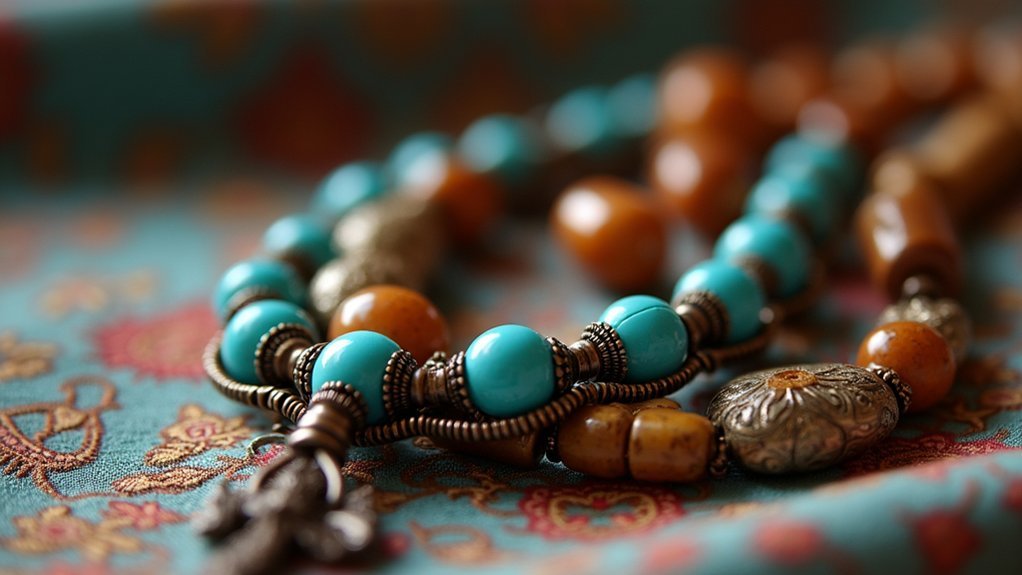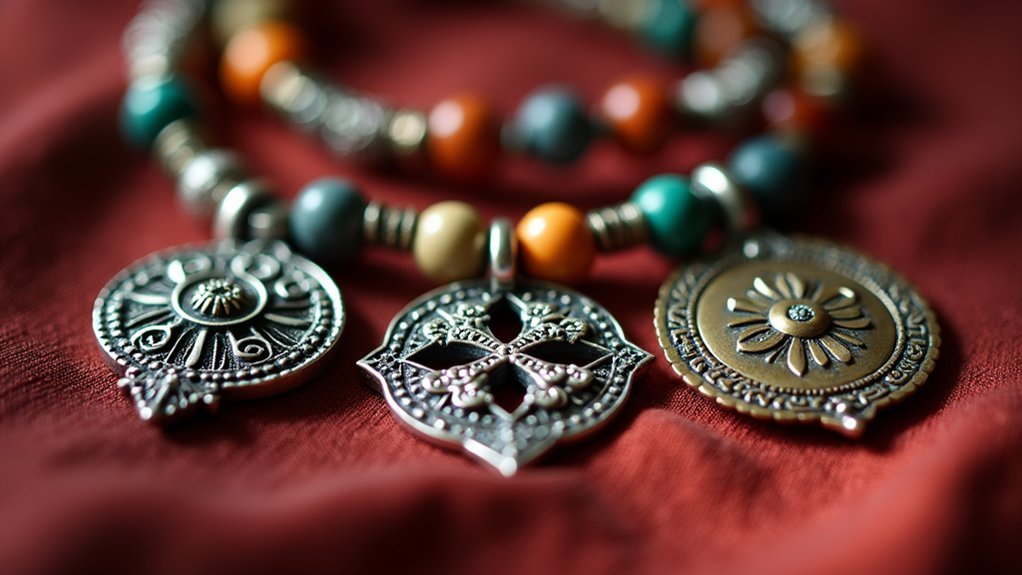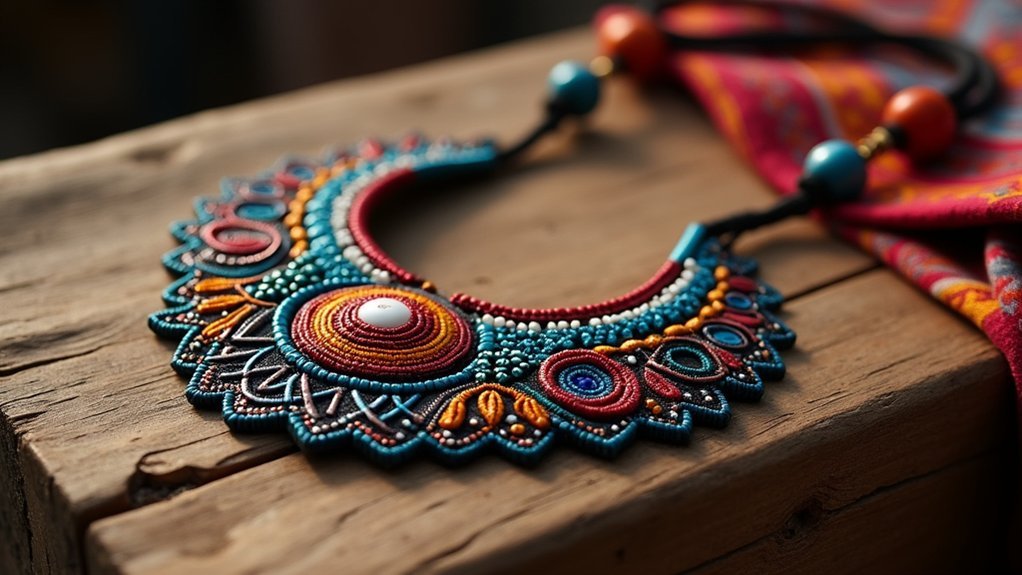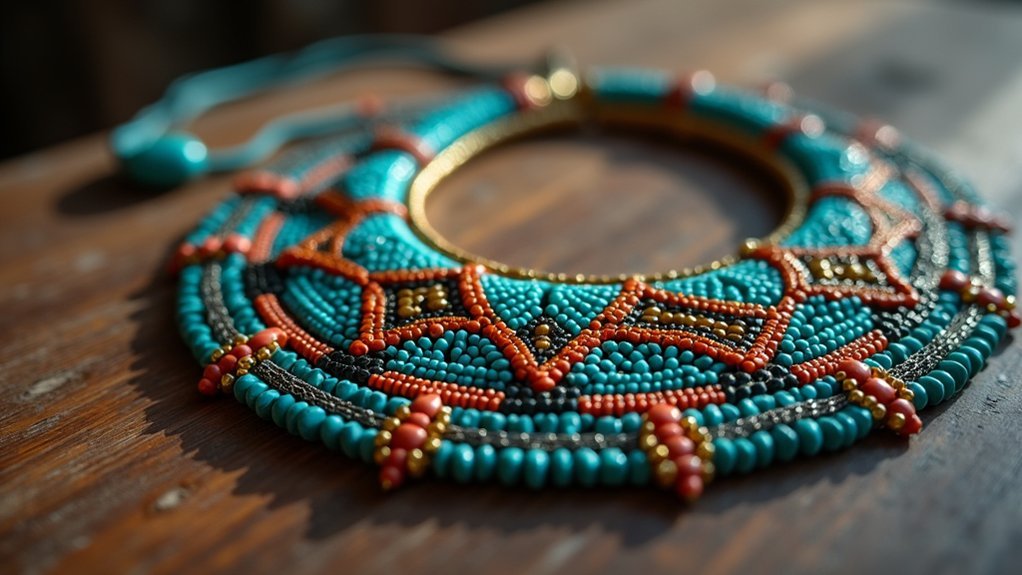Cultural appropriation in jewelry matters because it impacts Indigenous artisans’ livelihoods when their sacred symbols are copied without understanding or respect. When you create jewelry using cultural elements, you’re responsible for honoring their origins through research, proper attribution, and fair compensation to original communities. Thoughtful collaboration and education transform potential appropriation into genuine appreciation. Understanding these distinctions helps you become a more ethical creator and conscientious consumer of culturally-inspired jewelry.
7 Second-Level Headings for “Why Cultural Appropriation Matters in Jewelry Creation”

Respect forms the cornerstone of ethical jewelry creation when drawing inspiration from cultural traditions. When you design pieces influenced by other cultures, understanding their cultural significance prevents harmful appropriation that can diminish sacred symbols into mere decorative elements.
The line between appreciation and appropriation often blurs when creators commercialize designs without acknowledging their origins. You must recognize that jewelry from marginalized cultures carries histories of resistance and identity that deserve recognition beyond aesthetic value.
Cultural diversity enriches the jewelry landscape, but only when approached with genuine respect and research. Before incorporating symbols or techniques from another tradition, ask yourself: Are you honoring the source, compensating authentic artisans, and avoiding stereotypes?
These considerations transform potential exploitation into ethical engagement that celebrates rather than diminishes cultural heritage.
Defining the Line Between Appreciation and Appropriation
The boundary between cultural appreciation and appropriation often resembles a delicate tightrope that jewelry designers must carefully navigate. When you incorporate elements from different cultures into your work, intention and understanding become critical factors.
Cultural appreciation emerges from thorough research, consultation with community members, and respectful acknowledgment of a symbol’s significance.
Conversely, appropriation occurs when you extract cultural symbols for profit without proper context, particularly when existing power dynamics favor you over the originating culture.
Consider whether your design honors the symbol’s meaning or merely exploits its aesthetic appeal. The key distinction lies in your approach—are you engaging meaningfully with the culture, acknowledging its origins, and ensuring your work doesn’t misrepresent or commodify sacred elements?
Authentic appreciation requires both respect and relationship.
The Historical Context of Jewelry Symbols Across Cultures

When you examine ancient jewelry symbols, you’ll notice they’ve rarely remained confined to their cultures of origin, instead traveling along trade routes and evolving through centuries of cross-cultural contact.
The ankh symbol, for instance, originated in Egypt but later appeared in modified forms throughout the Mediterranean as cultures exchanged not just goods but meaningful iconography.
This migration of symbols doesn’t negate their cultural significance, but rather highlights how jewelry design has historically functioned as a visual language that’s continuously translated and reinterpreted across cultural boundaries.
Ancient Symbol Migration
Throughout millennia of human civilization, jewelry symbols have traversed continents and cultures, creating a rich tapestry of shared visual language that continues to influence modern designs.
You’ll find evidence of this cultural exchange dating back to the Late Iron Age, when British artisans incorporated Continental techniques into their creations, forever altering their cultural influences.
Consider the paisley design—originating in South Asia yet embraced globally through ancient symbol migration. This process wasn’t merely aesthetic; it reflected complex negotiations of identity as symbols shifted in meaning while crossing borders.
What begins as sacred in one culture might become purely decorative in another.
Understanding this historical context helps you distinguish between appropriation and appreciation when creators from different backgrounds incorporate elements that aren’t originally their own.
Cross-Cultural Jewelry Evolution
As ancient trade routes crisscrossed continents, jewelry evolved beyond mere adornment into powerful artifacts of cultural exchange.
When you wear jewelry symbols from different cultures, understanding their historical context transforms potential cultural appropriation into genuine appreciation.
Consider these historical patterns of jewelry evolution:
- Symbol Migration – Celtic knots integrated into Roman designs demonstrate how jewelry motifs travel across borders, adapting new meanings while retaining core symbolism.
- Technical Fusion – Cultural backgrounds blend when crafting techniques merge, as seen in Greco-Egyptian metalwork combining distinct aesthetic traditions.
- Contextual Transformation – Symbols gain layered significance as they’re adopted by different cultures, often respecting their origins while developing new cultural relevance.
This historical perspective helps you distinguish between appropriation and informed appreciation of jewelry’s rich multicultural heritage.
Economic Impact on Indigenous Artisans and Communities
While mass-produced imitations flood retail shelves, Indigenous artisans from Pueblo, Navajo, and Hopi communities watch their livelihoods erode.
When you purchase these knockoffs, you’re directly undermining the market for original works created by skilled Indigenous artisans who rely on jewelry sales for economic empowerment.
The cultural significance of authentic pieces extends beyond aesthetics—it represents generational knowledge and cultural heritage.
When appropriated designs sell for a fraction of authentic prices, craftspeople lose income that would otherwise support their families and communities.
These profits typically flow back into cultural preservation efforts and local economies.
Recognizing Sacred vs. Secular Elements in Jewelry Design

When you’re creating jewelry, understanding the difference between sacred symbols with spiritual significance and purely decorative elements isn’t just good ethics—it’s vital craftsmanship.
You’ll need to research the cultural context of symbols like Ganesha or Buddha before incorporating them into your pieces, as what might seem merely aesthetic could actually be deeply meaningful to entire communities.
Decoding Symbolic Meanings
Three critical elements separate sacred from secular symbolism in jewelry design: context, intention, and cultural connection.
When you incorporate sacred symbols into your creations, you must understand their cultural significance beyond aesthetic appeal to avoid cultural appropriation.
Before using a symbol in jewelry design, consider:
- Historical context – Research the symbol’s origins and traditional usage within its cultural heritage.
- Religious importance – Determine if the symbol holds spiritual significance that requires respectful treatment.
- Community perspective – Consult with members of the originating culture about appropriate representation.
Your responsibility as a designer extends beyond craftsmanship to cultural respect.
When you decode symbolic meanings properly, you honor the communities that created them while creating jewelry that celebrates rather than exploits cultural heritage.
Sacred Objects vs. Accessories
Distinguishing between sacred objects and everyday accessories forms the foundation of ethical jewelry design practice.
When you incorporate elements like Indigenous artifacts or prayer beads into your creations, you’re handling items with deep spiritual significance that often serve ceremonial purposes rather than decorative ones.
Cultural appropriation occurs when you transform sacred objects into fashion pieces without acknowledging their origins or meaning.
For example, Tibetan prayer beads used purely for aesthetic appeal disconnects them from their meditative purpose.
Before incorporating cultural elements into jewelry design, develop awareness of what constitutes sacred versus secular.
Ask whether an object holds religious importance or represents cultural heritage for a specific community.
This understanding helps you approach your craft with respect, avoiding the unintentional trivialization of meaningful traditions through your creative process.
Ethical Sourcing and Attribution in Cross-Cultural Design
While cultural boundaries blur in our interconnected world, ethical sourcing and proper attribution remain essential pillars in cross-cultural jewelry design.
When you incorporate elements from another culture, you’ve got a responsibility to acknowledge origins and support the artisans who originated these designs. This approach prevents cultural appropriation while fostering cross-cultural respect.
To practice ethical sourcing in your jewelry creation:
Ethical jewelry design demands research, authentic sourcing, and cultural attribution—responsibilities we embrace as conscious creators.
- Research cultural implications of symbols and techniques before incorporating them into your work
- Purchase authentic jewelry directly from Indigenous artisans and compensate them fairly
- Provide proper attribution by acknowledging the cultural origins of your design elements
Building Respectful Collaborations With Cultural Communities

Moving beyond ethical sourcing, true cultural respect emerges through authentic partnerships. When you engage directly with community members, you’ll gain invaluable insights into their symbols and traditions, transforming potential appropriation into genuine appreciation.
| Collaboration Approach | Community Benefit |
|---|---|
| Partner with local artisans | Economic support and fair compensation |
| Maintain open dialogue | Guarantees accurate cultural representation |
| Seek explicit consent | Validates authentic use of symbols |
| Share platform opportunities | Amplifies underrepresented voices |
| Continuous education | Deepens mutual respect and understanding |
You’ll find these collaborations aren’t just ethical—they’re enriching. By listening actively and investing in relationships with cultural communities, your jewelry creations will reflect respect rather than exploitation. This collaborative approach honors traditions while supporting the people who’ve cultivated these artistic expressions for generations.
Frequently Asked Questions
Why Does Cultural Appropriation Matter?
Cultural appropriation matters because you’re taking symbols from marginalized cultures without permission or understanding. It’s disrespectful, perpetuates stereotypes, exploits others’ heritage for profit, and reinforces historical power imbalances between communities.
What Is the Cultural Significance of Jewelry?
Jewelry connects you to your heritage, symbolizing identity and milestones in your life. You’re wearing stories of your culture through materials and designs that represent ancestral traditions and communal values you cherish.
Is It Cultural Appropriation to Wear Native Jewelry?
It can be appropriation if you’re wearing Native jewelry without understanding its cultural significance. Support Indigenous artisans directly, learn about the piece’s heritage, and wear it respectfully to honor rather than exploit their traditions.
How Can You Avoid Cultural Appropriation When Creating Artistic Work?
You can avoid cultural appropriation in artistic work by researching thoroughly, collaborating with artists from the source culture, giving proper credit, using non-culturally specific elements, and remaining open to feedback about your creations.
In Summary
When you create or wear jewelry inspired by other cultures, you’re making choices that matter. Be mindful of the stories, symbols, and communities behind each design. You’ll enrich the jewelry world by researching, crediting sources, collaborating respectfully, and supporting indigenous artisans. Cultural respect isn’t limiting—it’s liberating. Your conscious approach to cultural elements in jewelry can honor traditions while still expressing your unique creative vision.





Leave a Reply